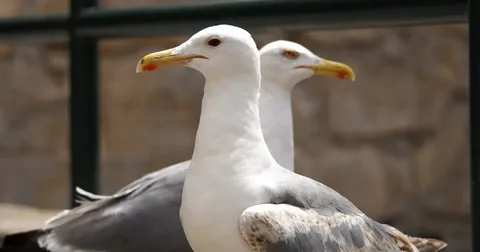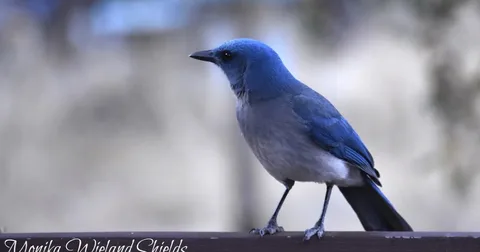American Avocet Birds What Makes Unique in the USA
American Avocet Bird (Recurvirostra americana) is one of North America’s most enchanting and visually striking shorebirds. With its rhythmic feeding motions, delicate stance, and migratory lifestyle, the American Avocet is not just a symbol of wetland beauty but also an indicator of ecosystem health.
In this article, we will explore the physical traits, habitats, feeding behavior, breeding patterns, and conservation status of this extraordinary bird in detail.
1. Exquisite Physical Features and Seasonal Elegance
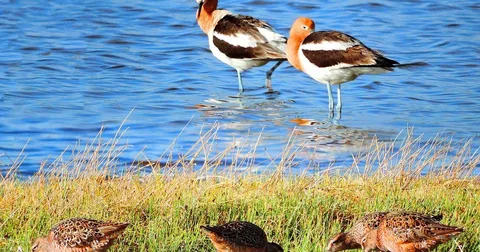
American Avocet Bird is admired for its refined elegance and distinctive adaptations. Adults typically measure 16–20 inches in length and possess a wingspan of 28–32 inches, making them medium-sized waders.
Unique Characteristics
- Seasonal Plumage: One of the most fascinating features of the Avocet is its dramatic color transformation. In winter, the plumage transitions to a softer grayish-white, giving the bird a more muted but equally graceful appearance.
- Signature Bill: The long, slender, upturned bill is perfectly designed for sweeping through shallow waters to catch aquatic prey.
- Legs and Feet: Their bluish-gray, stilt-like legs allow them to wade through deeper wetlands where other shorebirds cannot venture.
Flight Aesthetics: In flight, the Avocet exhibits elegant black-and-white wing patterns, making it easily recognizable against open skies.
2. Preferred Habitats and Geographic Rang American Avocet Birds
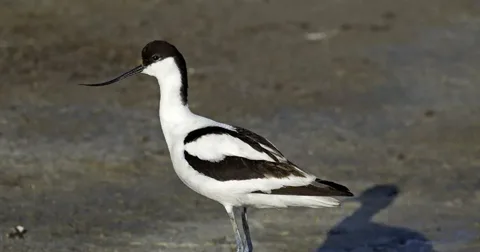
American Avocet Bird thrives in open, shallow-water environments where visibility is high, and food is abundant. These habitats also provide safety from predators and allow for efficient foraging.
Habitats
- Freshwater and saltwater marshes
- Tidal flats and estuaries
- Shallow lakes, ponds, and mudflats
- Coastal lagoons and inland wetlands
Distribution
- Breeding Range: During spring and summer, the American Avocet breeds primarily in the western and central United States, particularly in states such as Utah, California, Texas, and South Dakota.
- Wintering Grounds: As temperatures drop, these birds migrate south to warmer regions along the **southern U.S.
Their dependence on wetlands makes them highly vulnerable to habitat loss. Conservation of these ecosystems is crucial for sustaining healthy populations.
3. Feeding Strategy and Specialized Foraging Technique American Avocet Birds
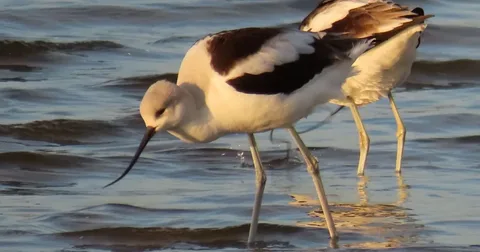
Perhaps the most mesmerizing behavior of the American Avocet is its unique feeding method. Instead of pecking like many other shorebirds, Avocets sweep their upturned bills side-to-side in shallow waters, feeling for prey rather than relying solely on sight.
Diet Composition
- Insects & Larvae: Mosquito larvae, beetles, and midges
- Crustaceans & Amphipods: Small shrimps and aquatic invertebrates
- Tiny Fish & Tadpoles: Opportunistic feeders during the breeding season
- Seeds & Aquatic Vegetation: Supplements their diet when animal prey is scarce
Foraging Behavior
- Avocets feed both day and night, using their sensitive bill tips to detect prey.
- They often forage in synchronized groups, moving in unison across shallow waters.
- During low tide, they exploit mudflats and tidal pools, taking advantage of exposed food sources.
This adaptable feeding strategy highlights the American Avocet’s evolutionary ingenuity and makes it an efficient hunter in diverse aquatic environments.
4. Breeding Rituals and Parental Care
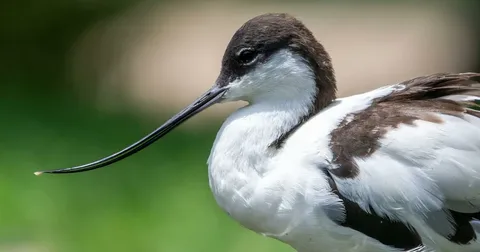
The breeding season, which typically begins in April and lasts through July, brings a dramatic transformation to the American Avocet’s behavior and appearance.
Courtship Displays
Males perform elaborate mating rituals, including graceful dances, bill-dipping, and synchronized movements to impress females.
Nesting Habits
- Nests are simple shallow scrapes built on bare sandbars, islands, or mudflats close to water.
- Parents line the nests with grass, shells, or feathers to protect the eggs.
Eggs and Chicks
- A typical clutch contains 3 to 4 eggs.
- Both parents **share incubation duty ** about 23 to 25 days.
- Chicks are precocial—they hatch with open eyes, covered in down, and can walk and feed themselves within hours.
5. American Avocet Birds Conservation Challenges and Ecological Significance
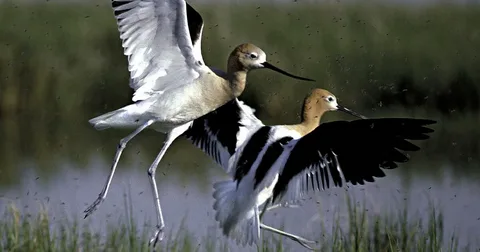
The American Avocet is currently listed as a species of Least Concern by the IUCN, but it faces growing threats that could jeopardize future populations.
Major Threats
- Habitat Loss: Wetlands are rapidly disappearing due to urbanization and agricultural expansion.
- Pollution: Industrial runoff and pesticides contaminate breeding and feeding areas.
- Climate Change: Altered rainfall patterns and rising sea levels impact wetland availability.
Conservation Efforts
- Protection of wildlife refuges and wetland sanctuaries
- Habitat restoration projects to maintain suitable breeding grounds
- Public education campaigns promoting shorebird conservation
Ecological Importance
The American Avocet plays a critical role in wetland ecosystems by:
- Controlling insect populations
- Acting as a bioindicator of environmental health
- Supporting the balance of aquatic food chains
Safeguarding the American Avocet means protecting entire wetland ecosystems that benefit countless species, including humans.
Conclusion
The American Avocet elegance, adaptability, ecological balance. Its striking appearance, unique feeding techniques, and complex breeding behaviors make it one of the most fascinating shorebirds in North America.
However, as wetlands continue to shrink under human pressure, the survival of this species depends on our collective conservation efforts. By protecting their habitats today, we ensure that future generations will continue to marvel at the graceful dance of the American Avocet across the continent’s wetlands.
 Birds Drawing Birds Drawing
Birds Drawing Birds Drawing

